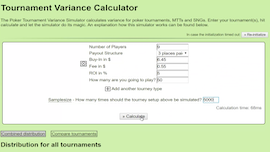Most individuals do not think of last table offer making technique till they in fact discover themselves at a last table. There are great deals of methods to deal at a last table, the most typical of which the ICM offer, which is where each gamer’s stack is valued according to the Independent Chip Model (ICM).
Many gamers nowadays understand ICM as a formula for playing end video game competition technique, however it was very first designed under a various name as an offer making approach by Mason Malmuth and David Harville. It was developed to approximate the possibilities of each gamer completing in each completing position based upon their stack size (ability is not consisted of in the estimation).
It’s finest to discuss the ICM handle an example, here is the last 4 gamers at a last table and an offer has actually been proposed. The possible reward is what they would win if they end up in the position they presently discover themselves in:
| Player | Chips | Possible Prize | ICM Value |
|---|---|---|---|
| Amy | 100,000 | $200 | $140.84 |
| Paul | 70,000 | $120 | $123.80 |
| Sophie | 50,000 | $80 | $108.96 |
| Tim | 20,000 | $50 | $76.40 |
In this example Amy is the chip leader and if she keeps her position will win $200, however a bad run of cards might see her bust next for $50. There are great deals of factors to make a last table offer and preventing difference is the most typical factor most last tables wind up in a handshake offer.
In this example Amy is on course to win $200 however with the ICM offer she would get $140.84. That is maybe a lot less than a chip leader may anticipate. Tim is the brief stack in 4th location however has an ICM worth of $76.40 which is nearly the 3rd location reward.
ICM offers do not consider ability and the very first time gamers see them they are typically stunned. They highlight a basic guideline of ICM which is that the more chips you have the less every one deserves. Usually ICM offers will see the chip leader need to quit the most in prospective rewards and the brief stack gets the greatest increase compared to what they would get for preserving their position.
This is the nature of offers, the chip leader needs to quit the most possible equity in favour of protecting a huge pay day. The brief stack needs to be incentivised to stop playing as they are basically freerolling after the bubble has burst.
To show why offers are structured in this manner, this is the portion opportunity of each gamer completing in each position, according to ICM:
| 1st | Second | 3rd | Fourth | |
|---|---|---|---|---|
| Amy | 41.7% | 31.9% | 20% | 6.4% |
| Paul | 29.2% | 31.2% | 27.5% | 12.2% |
| Sophie | 20.8% | 25.4% | 33.2% | 20.6% |
| Tim | 8.3% | 11.6% | 19.3% | 60.8% |
Tim comes last 60.8% of the time, however 39.2% of the time he handles 3rd or much better, which would get him $80+. This is why he gets to secure a quantity near that 3rd location reward. Amy wins 41.7% of the time however gets a location lower than her ICM worth 58.3% of the time. The majority of the time Amy gets less than her ICM payment, so securing $140.84 threat complimentary is in fact a beneficial result.
Individuals who do not comprehend ICM will frequently turn down an offer when they have a huge stack and snap the hand off of anybody who uses them near ICM as a brief stack. It’s most likely more crucial for offer making to comprehend these ending up position circulations than it is to comprehend the real ICM worth of your stack (you can do them yourself at PrimeDope).
Next time we will take a look at an alternative type of last table offer referred to as the chip slice.
Related Resources

The fact of difference Our Twitch coach LemOn36 with a

guide on variation
for money video games MTT variation Collin Moshman describes the ins and outs of competition difference